Promoting Health in Extended Care
VerifiedAdded on 2023/06/13
|8
|2885
|293
AI Summary
This article discusses the case of an older patient named Amalie and how Levett-Jones clinical reasoning and Miller’s Functional Consequences Theory were used to identify nursing prioritise and provide care. The article covers topics such as pain, impaired physical mobility, and impaired vision, and how goals were established and actions were taken to improve Amalie's condition. The article concludes that this type of care is vital for older people and is scientifically validated in numerous studies.
Contribute Materials
Your contribution can guide someone’s learning journey. Share your
documents today.

Promoting Health in Extended Care
1
1
Secure Best Marks with AI Grader
Need help grading? Try our AI Grader for instant feedback on your assignments.
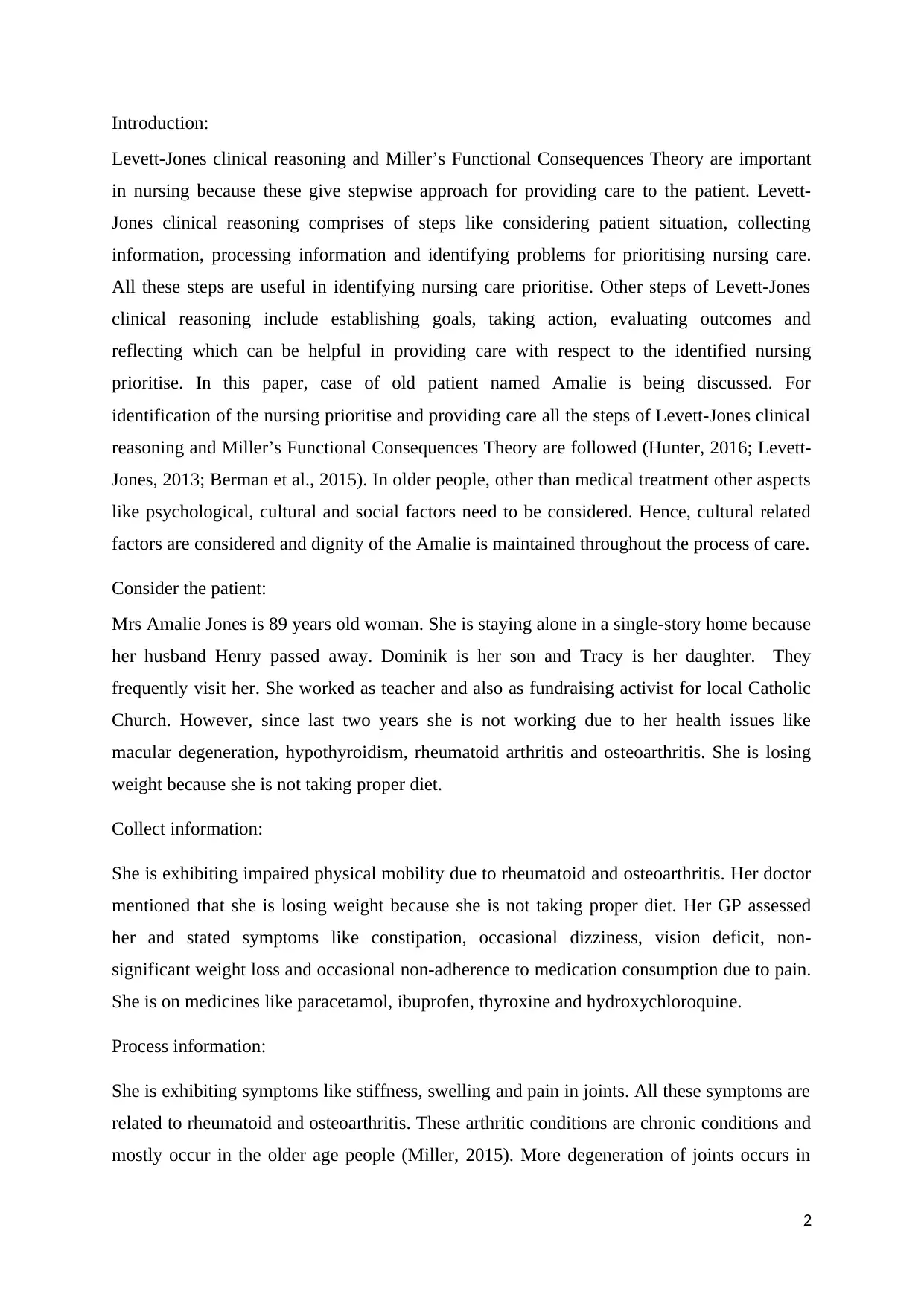
Introduction:
Levett-Jones clinical reasoning and Miller’s Functional Consequences Theory are important
in nursing because these give stepwise approach for providing care to the patient. Levett-
Jones clinical reasoning comprises of steps like considering patient situation, collecting
information, processing information and identifying problems for prioritising nursing care.
All these steps are useful in identifying nursing care prioritise. Other steps of Levett-Jones
clinical reasoning include establishing goals, taking action, evaluating outcomes and
reflecting which can be helpful in providing care with respect to the identified nursing
prioritise. In this paper, case of old patient named Amalie is being discussed. For
identification of the nursing prioritise and providing care all the steps of Levett-Jones clinical
reasoning and Miller’s Functional Consequences Theory are followed (Hunter, 2016; Levett-
Jones, 2013; Berman et al., 2015). In older people, other than medical treatment other aspects
like psychological, cultural and social factors need to be considered. Hence, cultural related
factors are considered and dignity of the Amalie is maintained throughout the process of care.
Consider the patient:
Mrs Amalie Jones is 89 years old woman. She is staying alone in a single-story home because
her husband Henry passed away. Dominik is her son and Tracy is her daughter. They
frequently visit her. She worked as teacher and also as fundraising activist for local Catholic
Church. However, since last two years she is not working due to her health issues like
macular degeneration, hypothyroidism, rheumatoid arthritis and osteoarthritis. She is losing
weight because she is not taking proper diet.
Collect information:
She is exhibiting impaired physical mobility due to rheumatoid and osteoarthritis. Her doctor
mentioned that she is losing weight because she is not taking proper diet. Her GP assessed
her and stated symptoms like constipation, occasional dizziness, vision deficit, non-
significant weight loss and occasional non-adherence to medication consumption due to pain.
She is on medicines like paracetamol, ibuprofen, thyroxine and hydroxychloroquine.
Process information:
She is exhibiting symptoms like stiffness, swelling and pain in joints. All these symptoms are
related to rheumatoid and osteoarthritis. These arthritic conditions are chronic conditions and
mostly occur in the older age people (Miller, 2015). More degeneration of joints occurs in
2
Levett-Jones clinical reasoning and Miller’s Functional Consequences Theory are important
in nursing because these give stepwise approach for providing care to the patient. Levett-
Jones clinical reasoning comprises of steps like considering patient situation, collecting
information, processing information and identifying problems for prioritising nursing care.
All these steps are useful in identifying nursing care prioritise. Other steps of Levett-Jones
clinical reasoning include establishing goals, taking action, evaluating outcomes and
reflecting which can be helpful in providing care with respect to the identified nursing
prioritise. In this paper, case of old patient named Amalie is being discussed. For
identification of the nursing prioritise and providing care all the steps of Levett-Jones clinical
reasoning and Miller’s Functional Consequences Theory are followed (Hunter, 2016; Levett-
Jones, 2013; Berman et al., 2015). In older people, other than medical treatment other aspects
like psychological, cultural and social factors need to be considered. Hence, cultural related
factors are considered and dignity of the Amalie is maintained throughout the process of care.
Consider the patient:
Mrs Amalie Jones is 89 years old woman. She is staying alone in a single-story home because
her husband Henry passed away. Dominik is her son and Tracy is her daughter. They
frequently visit her. She worked as teacher and also as fundraising activist for local Catholic
Church. However, since last two years she is not working due to her health issues like
macular degeneration, hypothyroidism, rheumatoid arthritis and osteoarthritis. She is losing
weight because she is not taking proper diet.
Collect information:
She is exhibiting impaired physical mobility due to rheumatoid and osteoarthritis. Her doctor
mentioned that she is losing weight because she is not taking proper diet. Her GP assessed
her and stated symptoms like constipation, occasional dizziness, vision deficit, non-
significant weight loss and occasional non-adherence to medication consumption due to pain.
She is on medicines like paracetamol, ibuprofen, thyroxine and hydroxychloroquine.
Process information:
She is exhibiting symptoms like stiffness, swelling and pain in joints. All these symptoms are
related to rheumatoid and osteoarthritis. These arthritic conditions are chronic conditions and
mostly occur in the older age people (Miller, 2015). More degeneration of joints occurs in
2
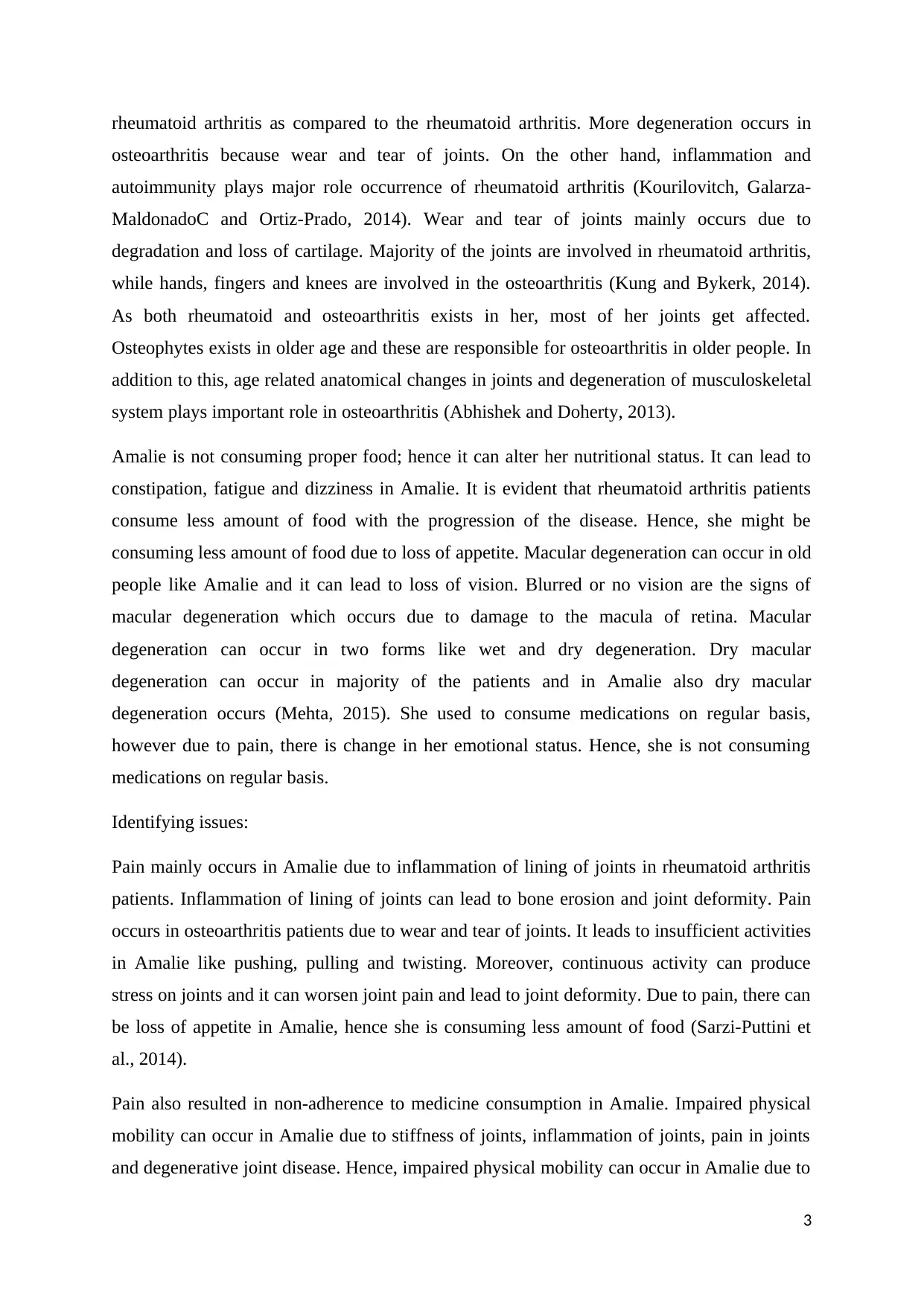
rheumatoid arthritis as compared to the rheumatoid arthritis. More degeneration occurs in
osteoarthritis because wear and tear of joints. On the other hand, inflammation and
autoimmunity plays major role occurrence of rheumatoid arthritis (Kourilovitch, Galarza-
MaldonadoC and Ortiz-Prado, 2014). Wear and tear of joints mainly occurs due to
degradation and loss of cartilage. Majority of the joints are involved in rheumatoid arthritis,
while hands, fingers and knees are involved in the osteoarthritis (Kung and Bykerk, 2014).
As both rheumatoid and osteoarthritis exists in her, most of her joints get affected.
Osteophytes exists in older age and these are responsible for osteoarthritis in older people. In
addition to this, age related anatomical changes in joints and degeneration of musculoskeletal
system plays important role in osteoarthritis (Abhishek and Doherty, 2013).
Amalie is not consuming proper food; hence it can alter her nutritional status. It can lead to
constipation, fatigue and dizziness in Amalie. It is evident that rheumatoid arthritis patients
consume less amount of food with the progression of the disease. Hence, she might be
consuming less amount of food due to loss of appetite. Macular degeneration can occur in old
people like Amalie and it can lead to loss of vision. Blurred or no vision are the signs of
macular degeneration which occurs due to damage to the macula of retina. Macular
degeneration can occur in two forms like wet and dry degeneration. Dry macular
degeneration can occur in majority of the patients and in Amalie also dry macular
degeneration occurs (Mehta, 2015). She used to consume medications on regular basis,
however due to pain, there is change in her emotional status. Hence, she is not consuming
medications on regular basis.
Identifying issues:
Pain mainly occurs in Amalie due to inflammation of lining of joints in rheumatoid arthritis
patients. Inflammation of lining of joints can lead to bone erosion and joint deformity. Pain
occurs in osteoarthritis patients due to wear and tear of joints. It leads to insufficient activities
in Amalie like pushing, pulling and twisting. Moreover, continuous activity can produce
stress on joints and it can worsen joint pain and lead to joint deformity. Due to pain, there can
be loss of appetite in Amalie, hence she is consuming less amount of food (Sarzi-Puttini et
al., 2014).
Pain also resulted in non-adherence to medicine consumption in Amalie. Impaired physical
mobility can occur in Amalie due to stiffness of joints, inflammation of joints, pain in joints
and degenerative joint disease. Hence, impaired physical mobility can occur in Amalie due to
3
osteoarthritis because wear and tear of joints. On the other hand, inflammation and
autoimmunity plays major role occurrence of rheumatoid arthritis (Kourilovitch, Galarza-
MaldonadoC and Ortiz-Prado, 2014). Wear and tear of joints mainly occurs due to
degradation and loss of cartilage. Majority of the joints are involved in rheumatoid arthritis,
while hands, fingers and knees are involved in the osteoarthritis (Kung and Bykerk, 2014).
As both rheumatoid and osteoarthritis exists in her, most of her joints get affected.
Osteophytes exists in older age and these are responsible for osteoarthritis in older people. In
addition to this, age related anatomical changes in joints and degeneration of musculoskeletal
system plays important role in osteoarthritis (Abhishek and Doherty, 2013).
Amalie is not consuming proper food; hence it can alter her nutritional status. It can lead to
constipation, fatigue and dizziness in Amalie. It is evident that rheumatoid arthritis patients
consume less amount of food with the progression of the disease. Hence, she might be
consuming less amount of food due to loss of appetite. Macular degeneration can occur in old
people like Amalie and it can lead to loss of vision. Blurred or no vision are the signs of
macular degeneration which occurs due to damage to the macula of retina. Macular
degeneration can occur in two forms like wet and dry degeneration. Dry macular
degeneration can occur in majority of the patients and in Amalie also dry macular
degeneration occurs (Mehta, 2015). She used to consume medications on regular basis,
however due to pain, there is change in her emotional status. Hence, she is not consuming
medications on regular basis.
Identifying issues:
Pain mainly occurs in Amalie due to inflammation of lining of joints in rheumatoid arthritis
patients. Inflammation of lining of joints can lead to bone erosion and joint deformity. Pain
occurs in osteoarthritis patients due to wear and tear of joints. It leads to insufficient activities
in Amalie like pushing, pulling and twisting. Moreover, continuous activity can produce
stress on joints and it can worsen joint pain and lead to joint deformity. Due to pain, there can
be loss of appetite in Amalie, hence she is consuming less amount of food (Sarzi-Puttini et
al., 2014).
Pain also resulted in non-adherence to medicine consumption in Amalie. Impaired physical
mobility can occur in Amalie due to stiffness of joints, inflammation of joints, pain in joints
and degenerative joint disease. Hence, impaired physical mobility can occur in Amalie due to
3
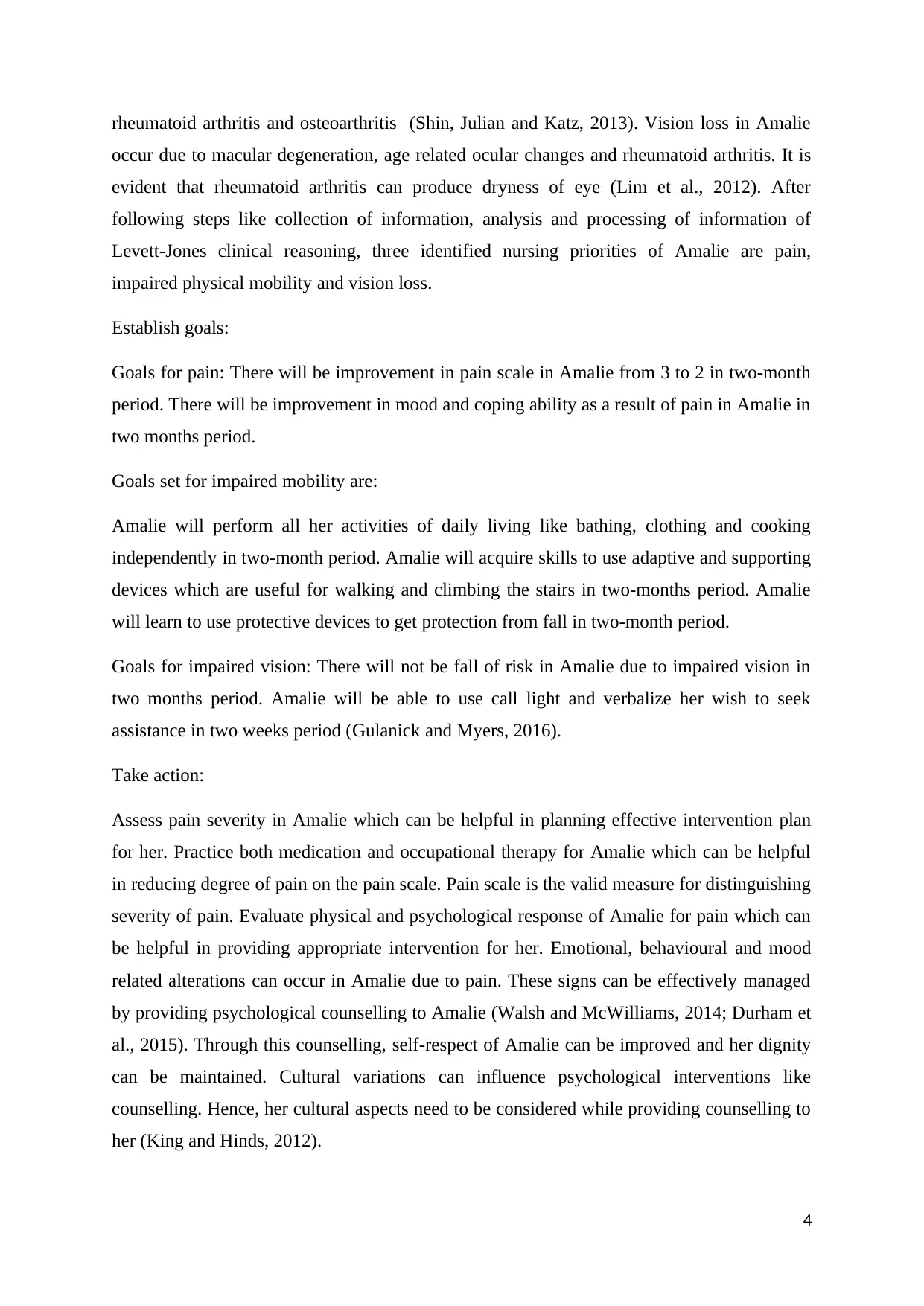
rheumatoid arthritis and osteoarthritis (Shin, Julian and Katz, 2013). Vision loss in Amalie
occur due to macular degeneration, age related ocular changes and rheumatoid arthritis. It is
evident that rheumatoid arthritis can produce dryness of eye (Lim et al., 2012). After
following steps like collection of information, analysis and processing of information of
Levett-Jones clinical reasoning, three identified nursing priorities of Amalie are pain,
impaired physical mobility and vision loss.
Establish goals:
Goals for pain: There will be improvement in pain scale in Amalie from 3 to 2 in two-month
period. There will be improvement in mood and coping ability as a result of pain in Amalie in
two months period.
Goals set for impaired mobility are:
Amalie will perform all her activities of daily living like bathing, clothing and cooking
independently in two-month period. Amalie will acquire skills to use adaptive and supporting
devices which are useful for walking and climbing the stairs in two-months period. Amalie
will learn to use protective devices to get protection from fall in two-month period.
Goals for impaired vision: There will not be fall of risk in Amalie due to impaired vision in
two months period. Amalie will be able to use call light and verbalize her wish to seek
assistance in two weeks period (Gulanick and Myers, 2016).
Take action:
Assess pain severity in Amalie which can be helpful in planning effective intervention plan
for her. Practice both medication and occupational therapy for Amalie which can be helpful
in reducing degree of pain on the pain scale. Pain scale is the valid measure for distinguishing
severity of pain. Evaluate physical and psychological response of Amalie for pain which can
be helpful in providing appropriate intervention for her. Emotional, behavioural and mood
related alterations can occur in Amalie due to pain. These signs can be effectively managed
by providing psychological counselling to Amalie (Walsh and McWilliams, 2014; Durham et
al., 2015). Through this counselling, self-respect of Amalie can be improved and her dignity
can be maintained. Cultural variations can influence psychological interventions like
counselling. Hence, her cultural aspects need to be considered while providing counselling to
her (King and Hinds, 2012).
4
occur due to macular degeneration, age related ocular changes and rheumatoid arthritis. It is
evident that rheumatoid arthritis can produce dryness of eye (Lim et al., 2012). After
following steps like collection of information, analysis and processing of information of
Levett-Jones clinical reasoning, three identified nursing priorities of Amalie are pain,
impaired physical mobility and vision loss.
Establish goals:
Goals for pain: There will be improvement in pain scale in Amalie from 3 to 2 in two-month
period. There will be improvement in mood and coping ability as a result of pain in Amalie in
two months period.
Goals set for impaired mobility are:
Amalie will perform all her activities of daily living like bathing, clothing and cooking
independently in two-month period. Amalie will acquire skills to use adaptive and supporting
devices which are useful for walking and climbing the stairs in two-months period. Amalie
will learn to use protective devices to get protection from fall in two-month period.
Goals for impaired vision: There will not be fall of risk in Amalie due to impaired vision in
two months period. Amalie will be able to use call light and verbalize her wish to seek
assistance in two weeks period (Gulanick and Myers, 2016).
Take action:
Assess pain severity in Amalie which can be helpful in planning effective intervention plan
for her. Practice both medication and occupational therapy for Amalie which can be helpful
in reducing degree of pain on the pain scale. Pain scale is the valid measure for distinguishing
severity of pain. Evaluate physical and psychological response of Amalie for pain which can
be helpful in providing appropriate intervention for her. Emotional, behavioural and mood
related alterations can occur in Amalie due to pain. These signs can be effectively managed
by providing psychological counselling to Amalie (Walsh and McWilliams, 2014; Durham et
al., 2015). Through this counselling, self-respect of Amalie can be improved and her dignity
can be maintained. Cultural variations can influence psychological interventions like
counselling. Hence, her cultural aspects need to be considered while providing counselling to
her (King and Hinds, 2012).
4
Secure Best Marks with AI Grader
Need help grading? Try our AI Grader for instant feedback on your assignments.
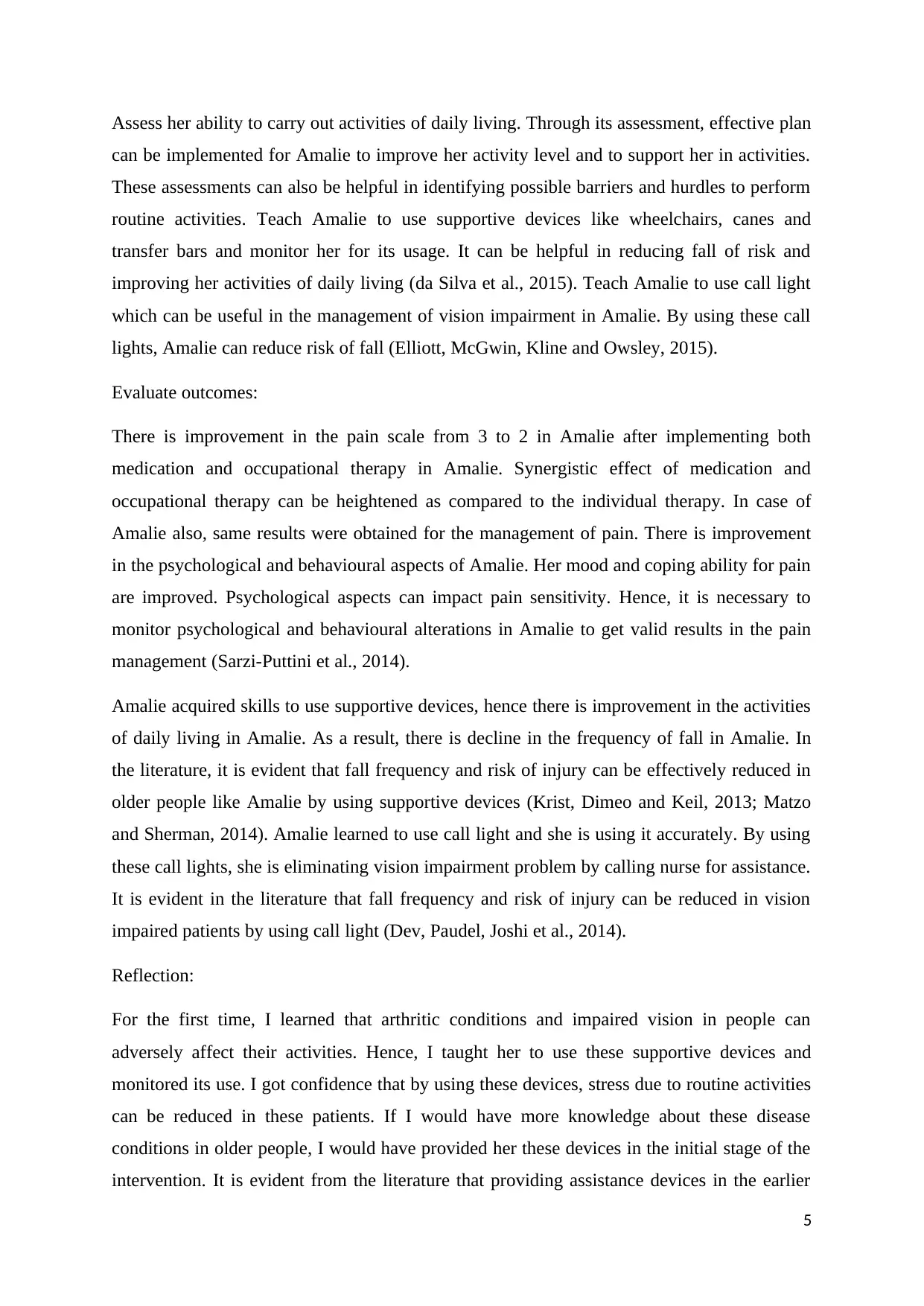
Assess her ability to carry out activities of daily living. Through its assessment, effective plan
can be implemented for Amalie to improve her activity level and to support her in activities.
These assessments can also be helpful in identifying possible barriers and hurdles to perform
routine activities. Teach Amalie to use supportive devices like wheelchairs, canes and
transfer bars and monitor her for its usage. It can be helpful in reducing fall of risk and
improving her activities of daily living (da Silva et al., 2015). Teach Amalie to use call light
which can be useful in the management of vision impairment in Amalie. By using these call
lights, Amalie can reduce risk of fall (Elliott, McGwin, Kline and Owsley, 2015).
Evaluate outcomes:
There is improvement in the pain scale from 3 to 2 in Amalie after implementing both
medication and occupational therapy in Amalie. Synergistic effect of medication and
occupational therapy can be heightened as compared to the individual therapy. In case of
Amalie also, same results were obtained for the management of pain. There is improvement
in the psychological and behavioural aspects of Amalie. Her mood and coping ability for pain
are improved. Psychological aspects can impact pain sensitivity. Hence, it is necessary to
monitor psychological and behavioural alterations in Amalie to get valid results in the pain
management (Sarzi-Puttini et al., 2014).
Amalie acquired skills to use supportive devices, hence there is improvement in the activities
of daily living in Amalie. As a result, there is decline in the frequency of fall in Amalie. In
the literature, it is evident that fall frequency and risk of injury can be effectively reduced in
older people like Amalie by using supportive devices (Krist, Dimeo and Keil, 2013; Matzo
and Sherman, 2014). Amalie learned to use call light and she is using it accurately. By using
these call lights, she is eliminating vision impairment problem by calling nurse for assistance.
It is evident in the literature that fall frequency and risk of injury can be reduced in vision
impaired patients by using call light (Dev, Paudel, Joshi et al., 2014).
Reflection:
For the first time, I learned that arthritic conditions and impaired vision in people can
adversely affect their activities. Hence, I taught her to use these supportive devices and
monitored its use. I got confidence that by using these devices, stress due to routine activities
can be reduced in these patients. If I would have more knowledge about these disease
conditions in older people, I would have provided her these devices in the initial stage of the
intervention. It is evident from the literature that providing assistance devices in the earlier
5
can be implemented for Amalie to improve her activity level and to support her in activities.
These assessments can also be helpful in identifying possible barriers and hurdles to perform
routine activities. Teach Amalie to use supportive devices like wheelchairs, canes and
transfer bars and monitor her for its usage. It can be helpful in reducing fall of risk and
improving her activities of daily living (da Silva et al., 2015). Teach Amalie to use call light
which can be useful in the management of vision impairment in Amalie. By using these call
lights, Amalie can reduce risk of fall (Elliott, McGwin, Kline and Owsley, 2015).
Evaluate outcomes:
There is improvement in the pain scale from 3 to 2 in Amalie after implementing both
medication and occupational therapy in Amalie. Synergistic effect of medication and
occupational therapy can be heightened as compared to the individual therapy. In case of
Amalie also, same results were obtained for the management of pain. There is improvement
in the psychological and behavioural aspects of Amalie. Her mood and coping ability for pain
are improved. Psychological aspects can impact pain sensitivity. Hence, it is necessary to
monitor psychological and behavioural alterations in Amalie to get valid results in the pain
management (Sarzi-Puttini et al., 2014).
Amalie acquired skills to use supportive devices, hence there is improvement in the activities
of daily living in Amalie. As a result, there is decline in the frequency of fall in Amalie. In
the literature, it is evident that fall frequency and risk of injury can be effectively reduced in
older people like Amalie by using supportive devices (Krist, Dimeo and Keil, 2013; Matzo
and Sherman, 2014). Amalie learned to use call light and she is using it accurately. By using
these call lights, she is eliminating vision impairment problem by calling nurse for assistance.
It is evident in the literature that fall frequency and risk of injury can be reduced in vision
impaired patients by using call light (Dev, Paudel, Joshi et al., 2014).
Reflection:
For the first time, I learned that arthritic conditions and impaired vision in people can
adversely affect their activities. Hence, I taught her to use these supportive devices and
monitored its use. I got confidence that by using these devices, stress due to routine activities
can be reduced in these patients. If I would have more knowledge about these disease
conditions in older people, I would have provided her these devices in the initial stage of the
intervention. It is evident from the literature that providing assistance devices in the earlier
5
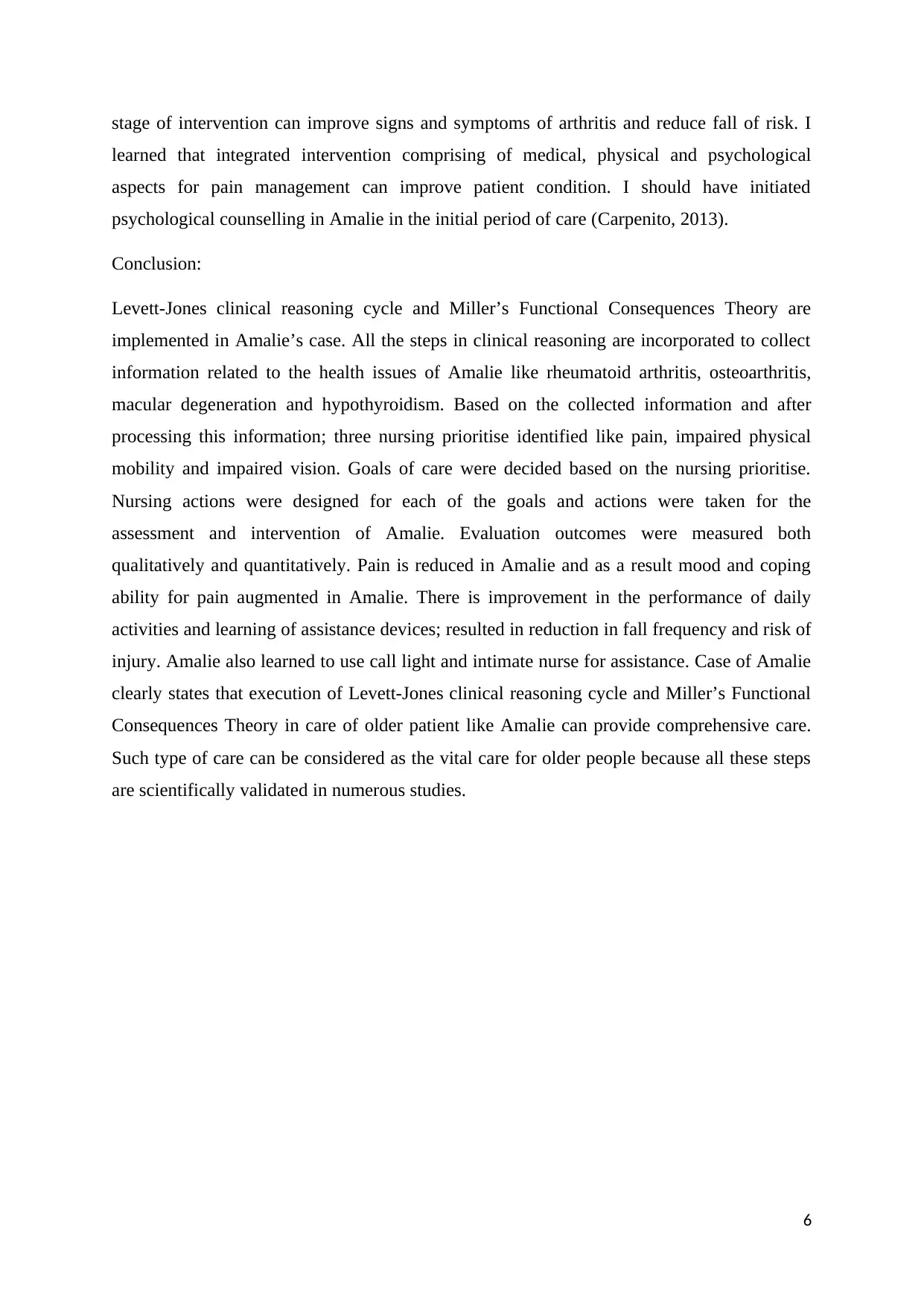
stage of intervention can improve signs and symptoms of arthritis and reduce fall of risk. I
learned that integrated intervention comprising of medical, physical and psychological
aspects for pain management can improve patient condition. I should have initiated
psychological counselling in Amalie in the initial period of care (Carpenito, 2013).
Conclusion:
Levett-Jones clinical reasoning cycle and Miller’s Functional Consequences Theory are
implemented in Amalie’s case. All the steps in clinical reasoning are incorporated to collect
information related to the health issues of Amalie like rheumatoid arthritis, osteoarthritis,
macular degeneration and hypothyroidism. Based on the collected information and after
processing this information; three nursing prioritise identified like pain, impaired physical
mobility and impaired vision. Goals of care were decided based on the nursing prioritise.
Nursing actions were designed for each of the goals and actions were taken for the
assessment and intervention of Amalie. Evaluation outcomes were measured both
qualitatively and quantitatively. Pain is reduced in Amalie and as a result mood and coping
ability for pain augmented in Amalie. There is improvement in the performance of daily
activities and learning of assistance devices; resulted in reduction in fall frequency and risk of
injury. Amalie also learned to use call light and intimate nurse for assistance. Case of Amalie
clearly states that execution of Levett-Jones clinical reasoning cycle and Miller’s Functional
Consequences Theory in care of older patient like Amalie can provide comprehensive care.
Such type of care can be considered as the vital care for older people because all these steps
are scientifically validated in numerous studies.
6
learned that integrated intervention comprising of medical, physical and psychological
aspects for pain management can improve patient condition. I should have initiated
psychological counselling in Amalie in the initial period of care (Carpenito, 2013).
Conclusion:
Levett-Jones clinical reasoning cycle and Miller’s Functional Consequences Theory are
implemented in Amalie’s case. All the steps in clinical reasoning are incorporated to collect
information related to the health issues of Amalie like rheumatoid arthritis, osteoarthritis,
macular degeneration and hypothyroidism. Based on the collected information and after
processing this information; three nursing prioritise identified like pain, impaired physical
mobility and impaired vision. Goals of care were decided based on the nursing prioritise.
Nursing actions were designed for each of the goals and actions were taken for the
assessment and intervention of Amalie. Evaluation outcomes were measured both
qualitatively and quantitatively. Pain is reduced in Amalie and as a result mood and coping
ability for pain augmented in Amalie. There is improvement in the performance of daily
activities and learning of assistance devices; resulted in reduction in fall frequency and risk of
injury. Amalie also learned to use call light and intimate nurse for assistance. Case of Amalie
clearly states that execution of Levett-Jones clinical reasoning cycle and Miller’s Functional
Consequences Theory in care of older patient like Amalie can provide comprehensive care.
Such type of care can be considered as the vital care for older people because all these steps
are scientifically validated in numerous studies.
6
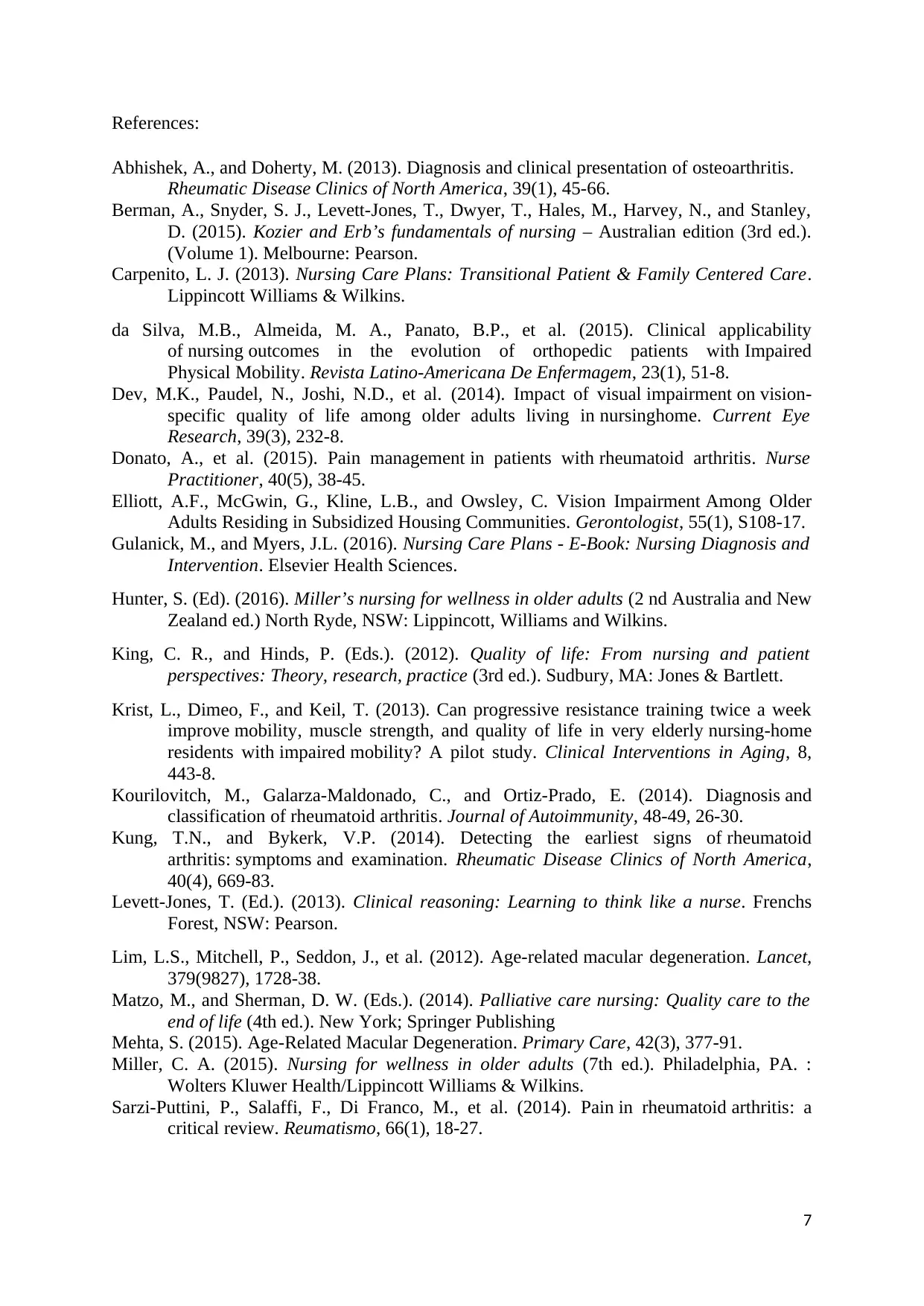
References:
Abhishek, A., and Doherty, M. (2013). Diagnosis and clinical presentation of osteoarthritis.
Rheumatic Disease Clinics of North America, 39(1), 45-66.
Berman, A., Snyder, S. J., Levett-Jones, T., Dwyer, T., Hales, M., Harvey, N., and Stanley,
D. (2015). Kozier and Erb’s fundamentals of nursing – Australian edition (3rd ed.).
(Volume 1). Melbourne: Pearson.
Carpenito, L. J. (2013). Nursing Care Plans: Transitional Patient & Family Centered Care.
Lippincott Williams & Wilkins.
da Silva, M.B., Almeida, M. A., Panato, B.P., et al. (2015). Clinical applicability
of nursing outcomes in the evolution of orthopedic patients with Impaired
Physical Mobility. Revista Latino-Americana De Enfermagem, 23(1), 51-8.
Dev, M.K., Paudel, N., Joshi, N.D., et al. (2014). Impact of visual impairment on vision-
specific quality of life among older adults living in nursinghome. Current Eye
Research, 39(3), 232-8.
Donato, A., et al. (2015). Pain management in patients with rheumatoid arthritis. Nurse
Practitioner, 40(5), 38-45.
Elliott, A.F., McGwin, G., Kline, L.B., and Owsley, C. Vision Impairment Among Older
Adults Residing in Subsidized Housing Communities. Gerontologist, 55(1), S108-17.
Gulanick, M., and Myers, J.L. (2016). Nursing Care Plans - E-Book: Nursing Diagnosis and
Intervention. Elsevier Health Sciences.
Hunter, S. (Ed). (2016). Miller’s nursing for wellness in older adults (2 nd Australia and New
Zealand ed.) North Ryde, NSW: Lippincott, Williams and Wilkins.
King, C. R., and Hinds, P. (Eds.). (2012). Quality of life: From nursing and patient
perspectives: Theory, research, practice (3rd ed.). Sudbury, MA: Jones & Bartlett.
Krist, L., Dimeo, F., and Keil, T. (2013). Can progressive resistance training twice a week
improve mobility, muscle strength, and quality of life in very elderly nursing-home
residents with impaired mobility? A pilot study. Clinical Interventions in Aging, 8,
443-8.
Kourilovitch, M., Galarza-Maldonado, C., and Ortiz-Prado, E. (2014). Diagnosis and
classification of rheumatoid arthritis. Journal of Autoimmunity, 48-49, 26-30.
Kung, T.N., and Bykerk, V.P. (2014). Detecting the earliest signs of rheumatoid
arthritis: symptoms and examination. Rheumatic Disease Clinics of North America,
40(4), 669-83.
Levett-Jones, T. (Ed.). (2013). Clinical reasoning: Learning to think like a nurse. Frenchs
Forest, NSW: Pearson.
Lim, L.S., Mitchell, P., Seddon, J., et al. (2012). Age-related macular degeneration. Lancet,
379(9827), 1728-38.
Matzo, M., and Sherman, D. W. (Eds.). (2014). Palliative care nursing: Quality care to the
end of life (4th ed.). New York; Springer Publishing
Mehta, S. (2015). Age-Related Macular Degeneration. Primary Care, 42(3), 377-91.
Miller, C. A. (2015). Nursing for wellness in older adults (7th ed.). Philadelphia, PA. :
Wolters Kluwer Health/Lippincott Williams & Wilkins.
Sarzi-Puttini, P., Salaffi, F., Di Franco, M., et al. (2014). Pain in rheumatoid arthritis: a
critical review. Reumatismo, 66(1), 18-27.
7
Abhishek, A., and Doherty, M. (2013). Diagnosis and clinical presentation of osteoarthritis.
Rheumatic Disease Clinics of North America, 39(1), 45-66.
Berman, A., Snyder, S. J., Levett-Jones, T., Dwyer, T., Hales, M., Harvey, N., and Stanley,
D. (2015). Kozier and Erb’s fundamentals of nursing – Australian edition (3rd ed.).
(Volume 1). Melbourne: Pearson.
Carpenito, L. J. (2013). Nursing Care Plans: Transitional Patient & Family Centered Care.
Lippincott Williams & Wilkins.
da Silva, M.B., Almeida, M. A., Panato, B.P., et al. (2015). Clinical applicability
of nursing outcomes in the evolution of orthopedic patients with Impaired
Physical Mobility. Revista Latino-Americana De Enfermagem, 23(1), 51-8.
Dev, M.K., Paudel, N., Joshi, N.D., et al. (2014). Impact of visual impairment on vision-
specific quality of life among older adults living in nursinghome. Current Eye
Research, 39(3), 232-8.
Donato, A., et al. (2015). Pain management in patients with rheumatoid arthritis. Nurse
Practitioner, 40(5), 38-45.
Elliott, A.F., McGwin, G., Kline, L.B., and Owsley, C. Vision Impairment Among Older
Adults Residing in Subsidized Housing Communities. Gerontologist, 55(1), S108-17.
Gulanick, M., and Myers, J.L. (2016). Nursing Care Plans - E-Book: Nursing Diagnosis and
Intervention. Elsevier Health Sciences.
Hunter, S. (Ed). (2016). Miller’s nursing for wellness in older adults (2 nd Australia and New
Zealand ed.) North Ryde, NSW: Lippincott, Williams and Wilkins.
King, C. R., and Hinds, P. (Eds.). (2012). Quality of life: From nursing and patient
perspectives: Theory, research, practice (3rd ed.). Sudbury, MA: Jones & Bartlett.
Krist, L., Dimeo, F., and Keil, T. (2013). Can progressive resistance training twice a week
improve mobility, muscle strength, and quality of life in very elderly nursing-home
residents with impaired mobility? A pilot study. Clinical Interventions in Aging, 8,
443-8.
Kourilovitch, M., Galarza-Maldonado, C., and Ortiz-Prado, E. (2014). Diagnosis and
classification of rheumatoid arthritis. Journal of Autoimmunity, 48-49, 26-30.
Kung, T.N., and Bykerk, V.P. (2014). Detecting the earliest signs of rheumatoid
arthritis: symptoms and examination. Rheumatic Disease Clinics of North America,
40(4), 669-83.
Levett-Jones, T. (Ed.). (2013). Clinical reasoning: Learning to think like a nurse. Frenchs
Forest, NSW: Pearson.
Lim, L.S., Mitchell, P., Seddon, J., et al. (2012). Age-related macular degeneration. Lancet,
379(9827), 1728-38.
Matzo, M., and Sherman, D. W. (Eds.). (2014). Palliative care nursing: Quality care to the
end of life (4th ed.). New York; Springer Publishing
Mehta, S. (2015). Age-Related Macular Degeneration. Primary Care, 42(3), 377-91.
Miller, C. A. (2015). Nursing for wellness in older adults (7th ed.). Philadelphia, PA. :
Wolters Kluwer Health/Lippincott Williams & Wilkins.
Sarzi-Puttini, P., Salaffi, F., Di Franco, M., et al. (2014). Pain in rheumatoid arthritis: a
critical review. Reumatismo, 66(1), 18-27.
7
Paraphrase This Document
Need a fresh take? Get an instant paraphrase of this document with our AI Paraphraser
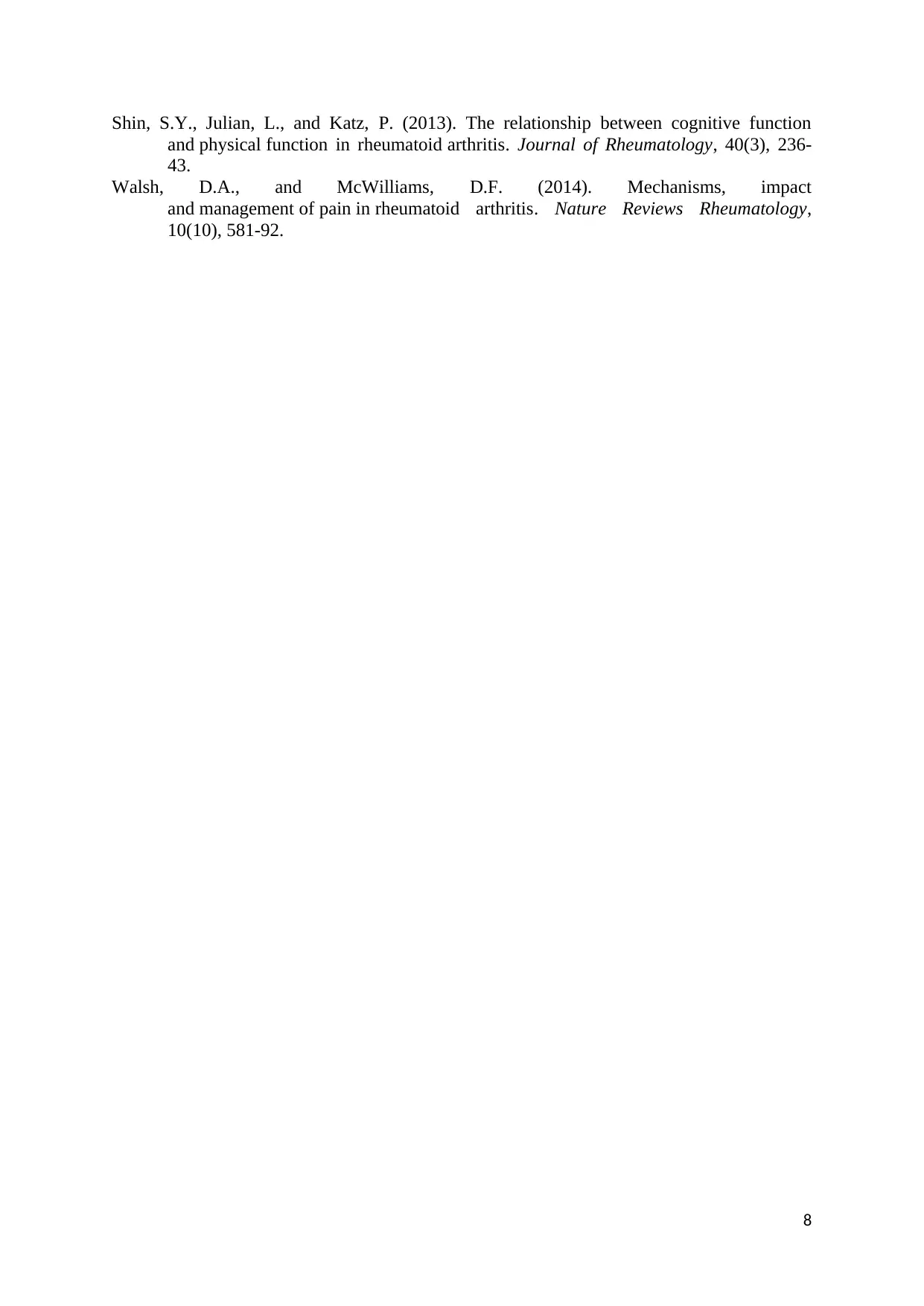
Shin, S.Y., Julian, L., and Katz, P. (2013). The relationship between cognitive function
and physical function in rheumatoid arthritis. Journal of Rheumatology, 40(3), 236-
43.
Walsh, D.A., and McWilliams, D.F. (2014). Mechanisms, impact
and management of pain in rheumatoid arthritis. Nature Reviews Rheumatology,
10(10), 581-92.
8
and physical function in rheumatoid arthritis. Journal of Rheumatology, 40(3), 236-
43.
Walsh, D.A., and McWilliams, D.F. (2014). Mechanisms, impact
and management of pain in rheumatoid arthritis. Nature Reviews Rheumatology,
10(10), 581-92.
8
1 out of 8
Related Documents
Your All-in-One AI-Powered Toolkit for Academic Success.
+13062052269
info@desklib.com
Available 24*7 on WhatsApp / Email
![[object Object]](/_next/static/media/star-bottom.7253800d.svg)
Unlock your academic potential
© 2024 | Zucol Services PVT LTD | All rights reserved.



